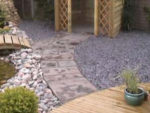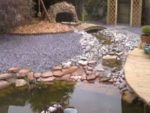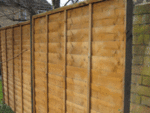When it comes to hard landscaping or most garden design, you will almost certainly need to know how to build some decking or to lay a patio. Very few gardens don’t have some fencing of one kind or other. In this section we have grouped all the topics that you will need for almost any hard landscaping project.
Some of the main areas that we cover are:
- Materials used for Decking: In our decking section you can find all the information that you need to fit and maintain you’re decking. Before you start you will need to know what are the options you have for the different types of decking that are available? Here are the most common materials that are used for making a deck or decking:
- Pressure Treated Softwood: This is a cheap and certainly the most common material that is use for domestic decking
- Durable Wood – Redwood or Cedar: This is a much more expensive approach but will require less maintenance and is thought to look more attractive
- Hardwood: These are similar in expense to cedar or redwood but much harder to work with. They also will require a specialist hardwood decking protection solution, but they do look amazing
- Composite Wood (CWD) or Plastic: This is a mixture of wood particles and plastic, or sometimes just pure plastic. These types of deck will weather very well, however it just doesn’t look nearly as good as real wood
- Metal: This is more unusual, but can make a real statement in the right garden or house. Usually aluminium is used as it is light and very durable, although not the cheapest option. We cover each of these in greater detail in our Decking Section, with lots on information about working with each kind
- Options for Paving and Patio Materials: There are a lot of options when it comes to paving and patios. The first choice is the material that you plan to use. Here are the most commonly used patio and paving materials:
- Sandstone: There are a huge range of colours and types so you are sure to find what you need, although the colour can vary or be blotchy across your batch of stones which can be frustrating. It is also easy to work so ideal for the DIY enthusiast, however it can get expensive if you don’t watch out
- Limestone: While it is easy to work with, there is a limited range of shades compared to sandstone, but generally the colour will be even and consistent. It will probably be a little more expensive than sandstone, and it will be stained easily or etched by acid rain if not treated properly
- Granite: This is an expensive but very durable option. It is hard to work but there are a spectacular range of types and colours
- Slate: This is a great material to work with although can be fragile and potentially susceptible to water damage. It is attractive and not too expensive too.
- Clay Bricks: These are great for DIY enthusiasts as they are easy to handle and install either in mortar or a bed of sand. They look great and are durable, however can be susceptible to water damage so need regular treatment
- Patio Pavers: Stone or concrete are the best, but they come in clay or even recycled plastic. They come in a range of sizes, which are uniform so always fit your design perfectly so are easy to install. They are hard wearing but they don’t look as ‘natural’ as the real thing.
- Concrete: This is one of the quickest ways to get a patio down. It is cheap but possibly not the most attractive unless designed with imagination. It is very durable, but can be subject to water damage
- Gravel: Is another quick and cheap way to get a surface laid. It is loose so there will be constant maintenance to rake the stone back. Make sure there is weed mesh under the stone to reduce the weeding that will be required
- Materials used for Driveways: The choices for driveways are considerable again. The options are similar to the Patios and Paving options however consideration needs to be given to the weight of vehicles that are going to use the drive way. Some of the most common options are:
- Gravel: This is one of the most popular and affordable options. When laid correctly maintenance is not considerable but there will be no need for any ‘repairs’. Gravel looks great and is also great for security as the noise deters would-be intruders
- Tarmac: Most roads are made of this so it is not surprising it’s a popular choice for our driveways. It is relatively cheap but durable and relatively maintenance free. It supports heavy loads and even comes in different colours nowadays!
- Concrete and Pattern Imprinted Concrete (PIC): Concrete is a quick and relatively cheap material to use, and with pattern imprinting it can make the boring looking concrete much more attractive, however it is prone to cracking and will needs repairs which are never as strong as the original concrete
- Block Paving: This is a durable driveway material if laid well. It is probably better for lighter traffic, but repairs can be done very cheaply by simply removing the damaged paver. The choice of pavers is near endless so aesthetically you will get whatever you need. It will need maintenance; cleaning sanding and resealing on a regular basis
- Bound and Bonded Resin Driveways: These are the two types of bonded resin driveways and they look amazing when they are done properly, although they are probably not really a DIY task
- Bonded resin driveways are created by putting the resin on the ground and then the small stones are scattered in a thin layer on top. This does mean that they are not water permeable so might need planning permission
- Bound Resin Driveways are created by coating the small stones in the resin which are then hand trowelled to create the surface. Being water permeable, they probably don’t need planning permission
- The Best Materials for Garden Fencing: Most gardens will have some form of fencing. Whether it is for security, screening or privacy, probably the biggest consideration is the cost. The options that you have for the materials for fencing are:
- Wood: This is the most popular choice; there is huge variation from panels to pickets and from palisades to hurdles. They can be painted, treated or left natural. On the whole they are cheap and quick to put up especially for the DIY enthusiast, however they are not very long lasting
- Vinyl or PVC: This is a very low maintenance fencing option, although is in not the cheapest to install and cannot be painted to change the appearance once installed. They will never need much maintenance, however are prone to mould or algae growth. It can be made to look very like wood but it is not just the same!
- Metal: The options are Aluminium and Steel (which has all but phased out wrought iron). Steel is long lasting – decades, rather than years – very strong and can be very beautiful. It is very expensing and hard to install making beyond the reach of most DIY enthusiasts. Aluminium is lightweight and will not corrode, but if dented will need to be replaced rather than repaired. It is probably better as a temporary fencing solution
For more information about driveways, their construction and how you can repair and maintain them, please see the section all about driveways.
For more information about the options for fencing, how to erect or repair fences and how to treat or maintain your fence then have a look at our fencing section.




